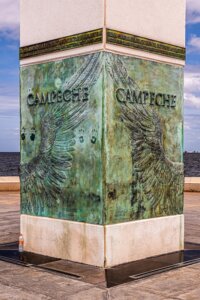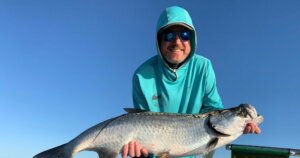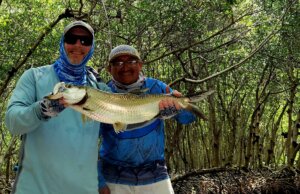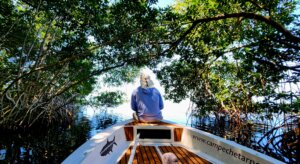
A group of six anglers including FCO members Jim Hillas, Paul Franklin and Robert Sheley recently returned from fishing in the Yucatán. The fishing was for baby tarpon in the Petenes Mangrove Ecoregion near the regional capital Campeche.
As part of their life cycle tarpon live in and near the mangroves until they are large enough to survive in open waters. Most are around 5-10 lbs. although some get up to 25-30 lbs. closer to the sea. We would leave the dock every morning at 5 am and motor north for an hour or so in the pitch black, looking at Orion and a brilliant Jupiter next to the moon. We never saw another boat outside of our party.
First light was magical, slipping into a channel where there could be 10 or more fish rolling in mirror flat water. Most of us used 8 wt. rods and a dry line. Successful flies included sardine imitations and a variety of surface patterns. Regardless of the fly, the takes were uniformly strong and violent and the angler had little time to set the hook. The necessary technique was sharp slip strikes to gain purchase in a dense bony mouth. The old side strike used for trout was guaranteed to produce a forlorn angler watching the line go limp. This author was particularly well known for this artless maneuver.

Derek Brown of Deschutes Angler Fly Shop with young tarpon
As commonly described these fish are strong and fight hard from hook-up to release. Numerous spectacular leaps were the norm and sometimes the rod would bend sharply under the boat during the end game. One of us even had a fish wrap his line six times around the push pole. His partner said he heard the tarpon chuckling as it swam off.

Jim Hillas with baby tarpon
A close second to the fishing for fun was staying in Campeche. It is a very old town that is equal parts beauty and charm. Evening meals were had in several restaurants and the food was excellent. Palates were tested in a locals’ taco place. Our mischievous host started us with lengua (tongue) followed by cow “face” and eyeballs. Jim Hillas described the latter as “gelatinous.” The rest of us took his word for it. There was much relief when we finished with al pastor served with pineapple, onion, cilantro and salsa.
Late fall is a slower time of year for fishing with summer described as the best. Most of us would trade the brutal heat for fewer fish and cooler weather. Regardless, a return visit is being planned by all.
Endnote: Campeche Tarpon was our host and provided excellent professional service while fishing and during every other aspect of the trip. Highly recommended. And thanks to the crew at the Deschutes Angler who gave solid advice on the fishing and spot-on suggestions for flies.
Dr. Robert Sheley


